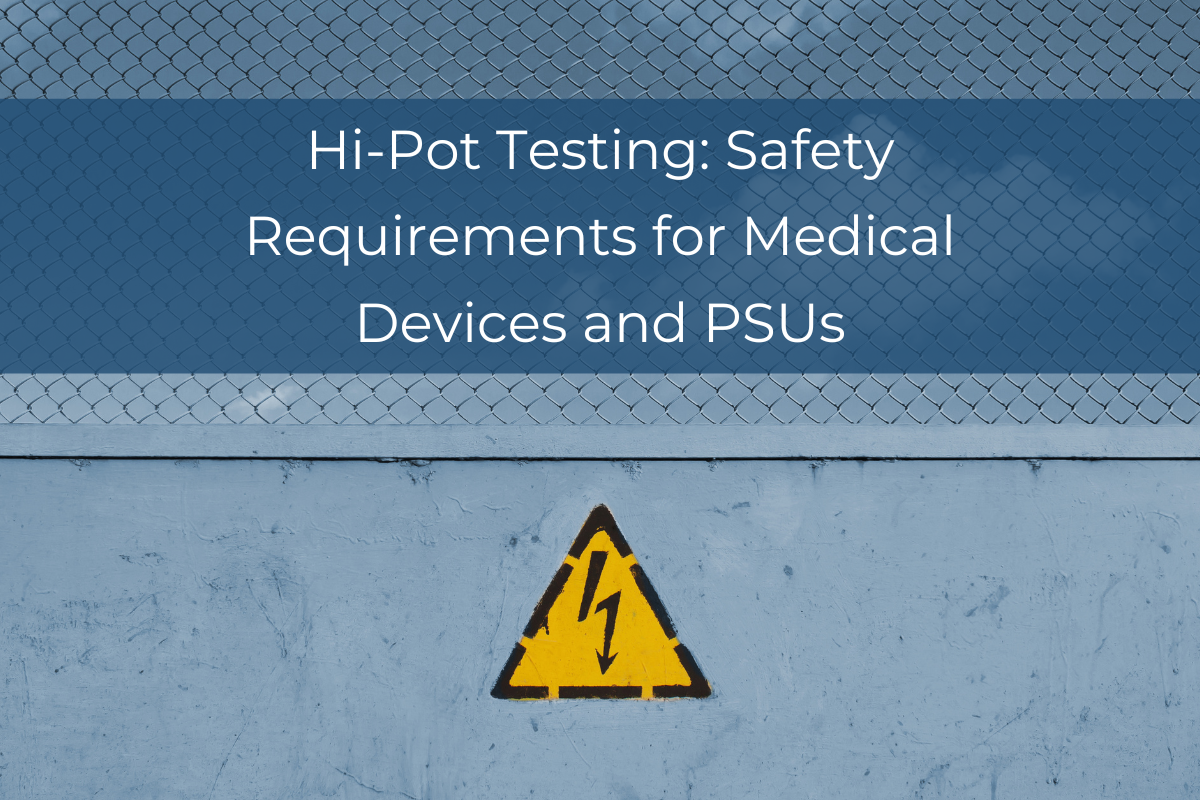Medical practitioners and patients shouldn’t have to worry or wonder about the safety of medical devices. One central standard for medical devices, and the power supplies that enable their operation, is concerned with high-potential (hi-pot) testing to ensure safety during voltage surges and spikes. These electrical events can harm people on either end of the equipment without proper insulation and safeguards. We’ll talk about what hi-pot testing is, what the standard looks like for medical devices, and what manufacturers should consider when choosing a compliant power supply.
What is Hi-Pot Testing for Medical Devices?
Hi-pot testing, also called high-potential testing or dielectric withstand testing, is a safety standard that determines whether the insulation of the medical device can handle voltage surges and transient spikes in voltage that exceed normal operating levels. Hi-pot testing is designed to protect operators and patients from these electrical hazards.
What are the Standards for Hi-Pot Testing?
The main international standard for hi-pot testing on medical devices is IEC 60601-1, which includes some specific testing requirements within the regulatory language based on the applied part and patient protection features of the device.
Applied Parts
Different types of applied parts carry different levels of risk and are subject to distinct standards. For example, Type B (Body) applied parts carry the least potential risk and include parts that operate in the vicinity of the patient but are generally not conductive or attached to the patient. These can include X-ray machines, hospital beds, and MRI scanners. There is usually at least one Means of Patient Protection (1 x MOPP) that separates Type B applied parts from patients.
“Floating” type applied parts make some kind of direct electrical contact with patients and require at least two Means of Patient Protection (2 x MOPP). These include Body Floating (BF) and Cardiac Floating (CF) applied parts, which make direct contact with the patient. In the case of CF applied parts, this contact would include the heart, such as defibrillators. All Floating type applied parts have more stringent requirements, with CF standards often being stricter than BF.
Patient Protection Standards
Insulation is the primary patient protection feature being tested with hi-pot standards. By looking at leakage current, the test can determine whether the insulation in the medical device is enough to withstand high-voltage events.
Other Standards for Hi-Pot Testing
Other national standards may also apply, depending on the target market of the medical device manufacturer. Most of these standards become harmonized at some point. For example, what is considered complaint in the U.S. will also be able to be applied in the EU – but it’s important to stay up-to-date on harmonization measures and what has and hasn’t been accepted in the target market countries.
What Are Some of the Key Requirements of Hi-Pot Testing for Medical Devices?
While each device will vary in what it needs to meet hi-pot standards, medical equipment will be tested at different voltages within a given duration and need to meet certain acceptance criteria.
If the medical device meets the requirements, this means that during the test, no excessive leakage current, breakdown, or flashover was observed.
What Should Medical Device Manufacturers Know About Hi-Pot Requirements When it Comes to Power Supplies?
Because hi-pot specifications for medical devices are focused on the safety of both the patient and the operator, the requirements are more stringent compared to other types of devices, and this extends to to medical power supply standards as well.
Medical power supply standards require that the PSU can handle different hi-pot potentials depending on the level of insulation used (basic or double) and the maximum line voltage.
For basic insulation, the hi-pot requirement for testing from primary-to-ground is 1500 V rms for 60 seconds.
For double insulation, the testing needs to be done at 4000 V rms for 60 seconds.
DC hi-pot testing may also be used, which involves taking the AC rms voltages and multiplying them by 1.414.
What Should Medical Device Designers Keep in Mind With Hi-Pot Testing?
Most power supplies, both commercial and medical-grade, may have trouble with hi-pot requirements from various agencies that test for conformance. This is because these agencies may test using 4000 rms placed from input to output. From primary to ground, this can be a level that over-stresses basic insulation. However, once the power supply is installed in the device, hi-pot potentials should be applied from the primary to the chassis and need to meet the required maximum of 1500 V AC or 2121 V DC.
RAM Technologies makes medical-grade power supplies that meet stringent hi-pot standards. If you are looking for a compliant PSU for your medical device, we can help you identify the wattage and form factor that will work best. We can also accommodate customizations for power supplies, harnesses, and cables. Contact us for more information.
RAM Technologies’ power supplies are 60601-1 3.2 certified and meet 60601-1-2 EMC standards. When you’re designing your medical device and need help with a PSU, contact us for details.
More Resources:
Downloadable Guide to IEC 60601-1
EMC Compliance and EN 61000-4-39: Magnetic Fields
EMC Compliance and EN 61000-4-11: Voltage Dips, Short Interruptions
